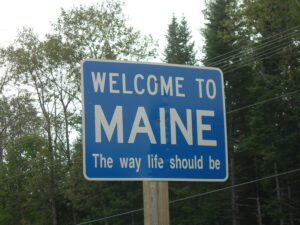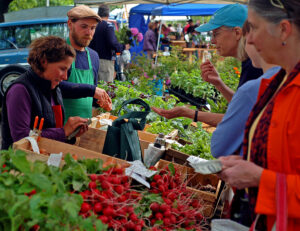Springtime in Maine is a beautiful thing. The morning air still holds the chill of winter. The faint scent of green and growing life tiptoes around your nose, suddenly bursting into fullness where a patch of afternoon sun has warmed a budding tree branch.
When I lived there, I loved waking up before dawn to call the cows in for milking and to check on the tender seedlings where they nestled cozily in the warm greenhouse. If springtime in Maine is beautiful, springtime on a farm in Maine is magical. Or rather, it used to be.

This year, when farmers should be milking cows and starting seedlings, many are instead staring into empty fields, writing heartbreaking emails to their customers, and waiting for the results of expensive tests. Why?
For decades, Maine farmers were told that biosolids residue (“sludge”) from municipal wastewater treatment plants and paper mills was a totally safe and economical fertilizer. Many used it liberally—belts are always tight on a small farm, especially in a state like Maine with such a short growing season. Now, however, the dirty secret inside that sludge is being revealed, and with it the source of these same farmers’ grief: PFAS.
What are PFAS?
PFAS (per- and polyfluoroalkyl substances) are a group of chemicals that have been used since the 1940s to create nonstick surfaces, to protect products from stains, and to fight fires. That polyester carpet in your office? Probably treated with PFAS to make that spilled coffee disappear with a few wipes. That bag of microwave popcorn you had as a snack? Likely lined with PFAS-containing materials to keep the delicious oils from soaking through. These chemicals are useful and ubiquitous. So what’s the problem?
The Problem With PFAS

PFAS are nicknamed “the forever chemical”—their strong carbon-fluorine bonds make them difficult to break down and many are resistant to heat, water, and oil. These characteristics mean that they can last in a natural ecosystem for up to a decade or even longer. And because they have been used increasingly since their inception, there are more and more of them accumulating in our economy and environment.
Their long-lasting nature makes them a problem even on organic farmlands. Organic farms are not permitted to use sludge as a fertilizer and three years of chemical-free cultivation is a prerequisite for organic certification. However, as the PFAS crisis in Maine is showing us, if a conventional farmer spread sludge even once on their fields in the 1980s, those fields may have PFAS on them now, regardless of current organic practices.
A Growing Concern

Maine farmers are the backbone of their communities, and many have generations-long relationships with the land they farm. Now, they may face economic ruin. Farmers are voluntarily removing their products from stores and turning away customers because they feel it is the right thing to do to protect their communities.
So far, there are no national standards for PFAS levels in food. Maine set its own thresholds for levels in milk and beef, but there are no limits for produce yet. PFAS are everywhere, nationwide, so it is likely that they are in out-of-state food sources too. There is no reason to believe Maine produce is more affected by PFAS than produce from anywhere else where sludge spreading has occurred.
The effects of PFAS accumulation in human bodies is still being investigated, but there is some evidence to suggest a link between certain exposures and serious health impacts. The risk from PFAS is from chronic exposure, not a one-time dose.
The most immediate impacts are being felt by the farmers themselves: some losing between $2,000 and $14,000 a week. And not every farmer qualifies, for federal assistance, leaving them without the means to survive the limbo between testing and results. That is a situation Mainers wouldn’t stand for.
We Can Get There From Here
In true Mainer spirit, neighbors are rallying to support each other and take action on PFAS. The Maine Organic Farmer and Gardener Association (MOFGA) and the Maine Farmland Trust have created a joint emergency relief fund to help farmers pay for testing, bridge their temporary income loss, and access mental health services. The fund prioritizes testing and recovery funds for indigenous Wabanaki farmers and farmers who make more than half their income from farming.
The legislature in Maine is making “a real effort to get ahead of the issue,” says Representative Bill Pluecker, who has championed many PFAS-related policies in the State House, including the recently passed ban on sludge applications. With extra money in the budget and innovative remediation techniques on the horizon, there is hope for a cleaner future. “We need to see other states follow our lead on getting PFAS out of our food supply,” says Representative Pluecker. But, he adds, “the Federal government also needs to crack down on manufacturers so that they have a clear legal fiscal liability for their pollution.”
What’s Next?
The Biden-Harris Administration announced last fall that it would be accelerating efforts to protect the United States from PFAS, because the problem with PFAS is not limited to Maine. As concerned residents, we have several pathways to action in front of us.
- Send a message to producers that we want a PFAS-free life. Buy clothes that use natural waterproofing agents like beeswax instead of Scotchgard and cook in cast iron instead of nonstick pans.
- Know what’s going on. Find out where PFAS are in your area and what you can do to mitigate their impact on your local food system.
- Help our neighbors. Reach out to your local elected officials and ask them to introduce or support PFAS regulations. Call your representatives and senators in Congress too. We need to put pressure on the EPA to step up regulation of PFAS and lower the allowable limit for human ingestion.
Everyone deserves clean water and food. Everyone deserves a healthy life, free from fear of toxic chemicals. And Maine farmers deserve a magical springtime again–the way it should be.

